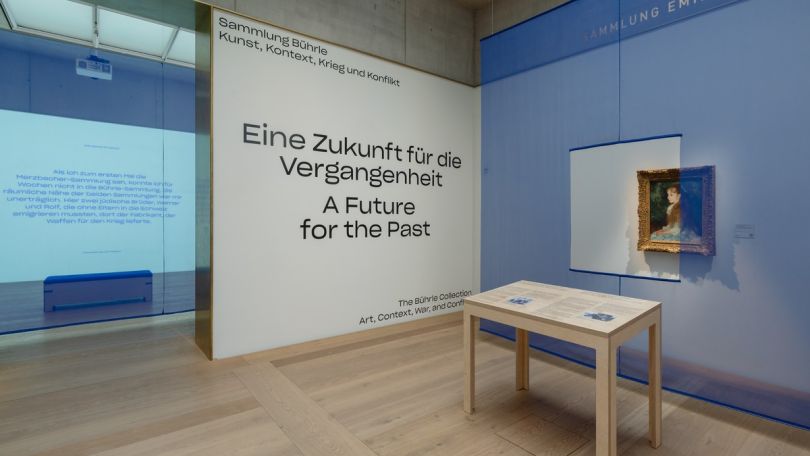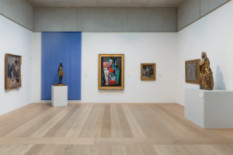Bührle was an entrepreneur who produced and sold weapons to anyone willing to pay a good price. Nazi Germany was no exception. He had no ethical constraints when it came to acquiring works of art. Many of them belonged to Jewish collectors before World War II, who were destroyed by the Nazis, and the origins of many others remain unclear.
Adding controversy to the exhibition is the fact that the Kunsthaus Zurich had close ties to Bührle, who was a member of the collection committee and funded the construction of Switzerland's new exhibition hall.
The exhibition currently held in the Bührle Hall goes beyond a mere art event. It has several dimensions. Firstly, the artistic dimension allows people to engage with genuine masterpieces of world art. Secondly, there's the ethical dimension concerning the museum's collaboration with Bührle and the right to exhibit works acquired under very ambiguous circumstances. Finally, there's the contextual dimension, which manifests through the exploration of the collection's history, its impact on the present, and the future. Thus, this exhibition transcends a mere art event.
«Petite Irene» by Pierre-Auguste Renoir is one of 633 exhibits.

Young Irene gazes beyond the painting, seemingly envisioning her future. What does she see there? Perhaps her marriage at 19 to the Jewish banker Moïse de Camondo, bearing two children, then leaving the family and remarrying. Her portrait would be kept by her daughter Beatrice. In 1942, Nazis arrest Irene, her husband, and their two children. All four are killed in Auschwitz, and the painting is stolen.
After the Nazi Germany's capitulation, allies find Irene's portrait in Berlin and return it to its owner. Irene managed to survive, hiding in Paris under the name of her second husband, Sampieri.
In 1949, Irene sells the portrait through intermediaries to collector Bührle.
Thus, «Petite Irene», whose family perished at the hands of the Nazis, becomes one of the 633 exhibits in the Bührle collection, amassed by a man who amassed immense wealth and formed a unique collection by selling weapons to murderers.
The story of «Petite Irene» is not unique. There are many such stories, which provoke a turbulent reaction and sharp debates in society.
After Emil's death, his widow Charlotte and children founded the E. G. Bührle Foundation, to which about a third of the collection—221 artworks out of 633—was transferred. The rest still remains in private ownership.
The core of the collection consists of French impressionist and post-impressionist paintings, also including works preparing for or accompanying impressionism, or serving as a starting point. Additionally, it includes a number of late medieval wooden sculptures. The value of the collection cannot be overstated; it could have been something to be proud of unequivocally, but the historical context forces questions and demands answers.
The controversial Bührle

During World War II, Bührle not only sold weapons to the Nazis and actively bought artworks but also engaged in theater, classical music, literature, sponsored science, financed the construction of a Catholic Church in Zurich's Erligkon. In this context, his main, seemingly noble, goal was to consolidate conservative art in Switzerland. But he also didn't forget about tax benefits. For instance, in 1942, the entrepreneur offered to finance a new building for Schaushpilhaus, and immediately began pressuring the city administration to allow this donation to be deducted from the military profit tax. However, he was unsuccessful in this.
The entrepreneur always aspired to enter Zurich's upper class. The art collection and thoughtful patronage were effective methods to achieve this goal. His efforts paid off. Bührle joined the Zurich Art Society (Zürcher Kunstgesellschaft), the association of Kunsthaus Zurich patrons, became a board member, and eventually became vice-chairman.
Kunsthaus and Bührle

The collector gifted the museum several works from his collection, including paintings by Claude Monet.
In the 1930s, the Zurich Art Society (Kunstgesellschaft) began planning the expansion of museum space, but the project stalled until Bührle donated 2 million francs to the building fund. This was a huge sum, equivalent to approximately 50 million francs today.
However, the architectural competition was postponed due to the war, but Bührle paid another 2 million francs to expedite the project. Nevertheless, a shortage of materials and the priority given to housing construction after the war delayed the start of construction until 1954. At that time, the financial situation of Kunstgesellschaft was quite unstable, and the patron promised to cover the full cost of construction if the city would provide the Kunsthaus land free of charge.
After his proposal, all parties approved the «new Kunsthaus building and the receipt of 6 million blood money». The project gained momentum, but Bührle did not live to see the opening of the exhibition hall, which took place in 1958. He passed away in November 1956.
The first exhibition in the 1200 m2 column-free hall, illuminated by natural light, was the first public presentation of Emil Bührle's collection and a significant social event.
Afterward, the «Bührle Gallery» remained the most important exhibition hall in Switzerland for a long time, where the exhibition is still held today. Thus, the name of a person who supplied weapons to the Nazis while engaging in patronage is engraved in the country's history. However, it is now time to reassess his contribution and the significance of the collection.
Discussions, context, and the search for answers

The exhibition at Kunsthaus has placed the collection of the Foundation at the center of public attention. There is a turbulent debate in the media and among citizens. Should it be exhibited in a museum that receives both state and private funding? Does the collection contain artworks stolen by the Nazis or those whose origins are unknown? Should all works acquired by Bührle be shown to the public? Finally, it raises the question of how a neutral country like Switzerland could allow Bührle to sell weapons to the Nazis?
In response to the sharp social, media, and political debate, the city and canton of Zurich, along with Kunstgesellschaft, convened a roundtable led by Felix Ulmann, who invited historian Rafael Gross to investigate the origins of Bührle's collection. His report is set to be published in the summer of 2024. This will be a logical conclusion to the unprecedented art and socially significant event of the exhibition and a reason for new questions and discussions.
Kunsthaus Zurich acknowledges the complexity of the issue and the ambiguity of its past position and expresses interest in continuing discussions. The museum believes that this collection should be displayed since the artworks themselves are in no way connected to the crimes committed by the National Socialists. They bear witness to these crimes and prompt the commemoration of the victims of Nazi terror, as well as a reevaluation of Switzerland's role in World War II. This, of course, can also influence the present, including considering the context of the war between Russia and Ukraine.
Three stages of this art event are planned.
- The current exhibition, which began in November 2023.
- Its expanded format, to be implemented in spring 2024, will include a deeper content and additional accompanying events.
- The publication of the final report by historian Rafael Gross, scheduled for summer 2024.
Kunsthaus aims to discuss all controversial topics involving a wide range of citizens. Some opinions can be heard in audio and video statements presented in the exhibition hall. Digital and offline surveys for visitors are also available, allowing everyone to participate in this socially significant process.
The current exhibition is just the first step in seeking answers to pressing questions; there is still a long way to go. So join this process.
Photos: Kunsthaus







